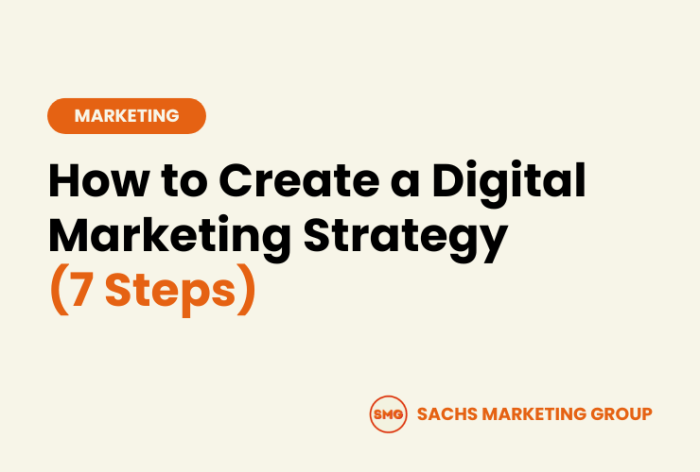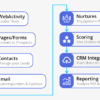Create a digital marketing strategy – Creating a digital marketing strategy is crucial for any business aiming to thrive in the online world. This guide will walk you through the essential steps, from defining your target audience to measuring results and adapting to market changes. We’ll cover everything you need to develop a comprehensive plan, ensuring your business reaches its full potential in the digital landscape.
This comprehensive strategy covers everything from identifying your ideal customer to optimizing your budget. We’ll delve into competitor analysis, content strategy, channel selection, and the crucial importance of continuous improvement. The detailed breakdown of each phase will help you navigate the complexities of digital marketing with confidence.
Defining the Target Audience
Understanding your ideal customer is crucial for crafting a successful digital marketing strategy. It’s not enough to simply know who you’re selling to; you need a deep understanding of their motivations, needs, and online habits. This knowledge allows you to tailor your messaging and choose the right channels to connect with them effectively.Defining your target audience is not a one-time exercise.
As your business evolves, so too should your understanding of your customers. Continuously analyzing data and adapting your approach based on new insights will ensure your marketing efforts remain relevant and impactful.
Ideal Customer Profile for a Sustainable Clothing Brand
This hypothetical brand, “EcoThreads,” focuses on ethically sourced, sustainable clothing. Their ideal customer is a conscious consumer who prioritizes environmental responsibility and social impact.
Demographics
EcoThreads’ target audience primarily comprises young adults (18-35) with a higher education level and disposable income. They are environmentally and socially conscious, with a strong interest in ethical production practices. Geographic location plays a role; urban centers with higher environmental awareness are likely to have a larger concentration of these consumers.
Psychographics
This demographic values sustainability and ethical production. They are often active in social causes, and their purchases reflect their values. They are likely to research brands’ environmental and social impact before making a purchase. They are digitally savvy and engage with online communities and social media platforms focused on sustainability.
Online Behavior
EcoThreads’ target audience frequently browses online marketplaces and social media platforms dedicated to sustainable living. They actively engage with brands and influencers who share similar values. They actively research products, and social proof (reviews and testimonials) is important to them. They are likely to follow eco-conscious brands on social media and engage with their content.
Pain Points
Consumers are concerned about the environmental impact of fast fashion. They seek clothing options that align with their values, but often find it challenging to identify genuinely sustainable brands. They may also face price barriers, as sustainable clothing can sometimes be more expensive.
Preferred Communication Channels and Platforms
EcoThreads’ target audience utilizes platforms like Instagram, Pinterest, and TikTok for inspiration and brand discovery. They appreciate transparent communication about the brand’s values and processes. Email newsletters and targeted ads on social media are effective. They value personalized recommendations and engaging content, including educational posts about sustainable fashion.
Successful Marketing Campaigns for Similar Audiences
Patagonia’s marketing campaigns, focused on environmental activism, have resonated with a similar audience. Their emphasis on storytelling and transparency, along with their support of environmental causes, resonates with the conscious consumer segment. Similarly, brands like Everlane, known for their transparency about production processes, have successfully engaged with a similar target audience.
Customer Segment Analysis
| Segment Name | Demographics | Psychographics | Online Behavior | Pain Points | Preferred Channels |
|---|---|---|---|---|---|
| Eco-Conscious Shoppers | Young adults (18-35), higher education, disposable income, urban areas | Value sustainability, ethical production, social impact, active in social causes | Active on social media, research products online, engage with brands on sustainable platforms | Finding genuinely sustainable brands, price barriers, lack of transparency | Instagram, Pinterest, TikTok, email newsletters, targeted ads |
Competitive Analysis
Understanding our competitors’ digital marketing strategies is crucial for developing a successful strategy. By analyzing their approaches, we can identify opportunities and avoid pitfalls. A thorough competitive analysis allows us to pinpoint areas where we can excel and tailor our strategies to better serve our target audience.A comprehensive competitive analysis provides a benchmark against which our own efforts can be measured.
It helps us to identify our unique selling propositions and highlight areas where we can offer superior value to customers. This analysis enables us to fine-tune our marketing efforts and maximize our return on investment.
Competitor Marketing Strategies
This section examines the digital marketing strategies of three major competitors, highlighting their strengths and weaknesses. These insights will inform our own strategy and help us identify opportunities for differentiation.
Competitor Profiles
- Company A: Focuses on a broad, mass market, utilizing social media and search engine optimization () to drive traffic. Their approach emphasizes brand awareness and building a large customer base. They excel in creating viral content and maintaining a consistent online presence.
- Company B: Targets a niche market segment known for its premium products. They leverage paid advertising and influencer marketing to reach a highly engaged audience. Their strategy emphasizes creating high-quality, visually appealing content tailored to the specific needs of their niche.
- Company C: Employs a multi-channel approach, combining email marketing, content marketing, and social media. They focus on providing valuable content and building trust with their target audience. They are effective at nurturing leads and converting them into customers.
Comparative Analysis of Competitor Strengths and Weaknesses
Analyzing competitors’ strengths and weaknesses provides valuable insight into our own positioning. The table below highlights key aspects of their digital marketing efforts.
| Competitor Name | Target Audience | Marketing Channels | Strengths | Weaknesses |
|---|---|---|---|---|
| Company A | Broad, mass market | Social Media, , Email Marketing | Strong brand awareness, large reach, viral content creation | Potential for diluted brand message, lack of personalized customer experience, may struggle with customer retention |
| Company B | Niche, premium segment | Paid Advertising, Influencer Marketing, Content Marketing | Strong customer engagement, targeted approach, high-quality content | Higher marketing costs, limited reach, reliance on influencers |
| Company C | Multi-faceted, value-driven | Email Marketing, Content Marketing, Social Media | Strong lead nurturing, valuable content, multi-channel approach | Potential for inconsistent messaging across channels, may struggle with attracting new customers |
Setting Objectives and KPIs
Defining clear objectives and key performance indicators (KPIs) is crucial for measuring the success of any digital marketing strategy. Without quantifiable goals, it’s challenging to track progress and demonstrate the return on investment (ROI). This section Artikels the SMART objectives and KPIs for our digital marketing strategy, providing a framework for evaluating performance and ensuring we stay on track.The SMART framework—Specific, Measurable, Achievable, Relevant, and Time-bound—provides a structured approach to defining objectives.
Crafting a killer digital marketing strategy is crucial, but it’s all part of a larger picture. Understanding your “go to market strategy” is key go to market strategy – how you’ll reach your target audience and position your product or service. Ultimately, a strong digital marketing plan needs to be deeply connected to your overall go-to-market approach to be truly effective.
Using this framework, we can establish precise targets and effectively measure progress. This detailed approach allows for effective tracking and adjustment of the strategy as needed.
SMART Objectives for Digital Marketing
Setting SMART objectives is fundamental to the success of a digital marketing campaign. These objectives must align with the overall business goals and be achievable within a defined timeframe. These specific and measurable objectives will provide direction and ensure that efforts are focused on achieving desired outcomes.
- Increase website traffic by 25% within the next quarter.
- Generate 50 qualified leads per month through targeted online advertising campaigns.
- Boost conversion rates on the website by 15% over the next three months.
- Increase brand awareness by 20% among the target audience, as measured by social media engagement and brand mentions.
Key Performance Indicators (KPIs)
KPIs are the metrics used to track progress towards the defined objectives. They provide a clear picture of how well the digital marketing strategy is performing and highlight areas needing attention. A range of KPIs will be tracked, encompassing website traffic, engagement, conversions, and customer acquisition.
- Website Traffic: This KPI measures the number of visitors to the website. Increased website traffic can be a sign of improved visibility and effectiveness of digital marketing campaigns. Tracking this metric provides insight into how well our digital marketing efforts are driving users to our website. Tools like Google Analytics provide comprehensive data on website traffic.
- Conversion Rates: This KPI measures the percentage of website visitors who complete a desired action, such as making a purchase or filling out a form. High conversion rates indicate that the website and marketing efforts are effectively persuading visitors to take the desired action. This metric directly reflects the effectiveness of the strategy in achieving business objectives.
- Social Media Engagement: This KPI encompasses metrics such as likes, shares, comments, and follower growth on social media platforms. Higher engagement signifies a stronger connection with the target audience and better brand awareness. Monitoring social media engagement is crucial for understanding the audience’s response to content and adapting strategies accordingly.
Tracking and Measuring KPIs
Accurate tracking of KPIs is essential for evaluating the effectiveness of digital marketing efforts. This section Artikels the methods used to track and measure each KPI.
- Website Traffic: Tracked using Google Analytics, which provides detailed data on website traffic sources, user behavior, and demographics. We’ll monitor daily, weekly, and monthly website traffic to identify trends and make necessary adjustments.
- Conversion Rates: Tracked by analyzing data from website analytics platforms, specifically focusing on the percentage of visitors completing desired actions. We’ll track these metrics regularly to identify areas for optimization and improvement.
- Social Media Engagement: Tracked through dedicated social media analytics dashboards (e.g., Facebook Insights, Twitter Analytics). This allows us to monitor key engagement metrics like likes, shares, and comments on posts. We’ll also monitor follower growth and analyze the reach of our content.
KPIs and Objectives Table
This table Artikels the objectives, corresponding KPIs, target values, and measurement methods.
| Objective | KPI | Target Value | Measurement Method |
|---|---|---|---|
| Increase website traffic by 25% | Website Visits | 25% increase over baseline | Google Analytics |
| Generate 50 qualified leads per month | Lead Generation | 50 leads/month | CRM platform, online forms |
| Boost conversion rates by 15% | Conversion Rate | 15% increase over baseline | Website analytics platform |
| Increase brand awareness by 20% | Social Media Engagement | 20% increase in brand mentions and interactions | Social media analytics dashboards |
Content Strategy
Crafting a compelling content strategy is paramount to attracting and retaining your target audience. A well-defined strategy, aligned with your overall marketing goals, ensures your content resonates with your ideal customer and drives meaningful engagement. It’s not just about creating content; it’s about strategically distributing it across the right channels to maximize its impact.A robust content strategy acts as a roadmap, guiding your content creation efforts.
It Artikels the type of content you’ll produce, the frequency of publishing, and the channels you’ll utilize to reach your target audience. This detailed plan will optimize your efforts and ensure a consistent flow of valuable information to your audience, fostering a stronger connection and ultimately driving conversions.
Content Calendar for the Next Three Months
A content calendar provides a structured approach to content creation, ensuring a consistent flow of valuable information to your audience. It helps manage the workload, anticipate needs, and optimize content for maximum impact. By planning in advance, you can maintain a steady stream of engaging content that resonates with your target audience.
Creating a killer digital marketing strategy is key for any business, especially if you want to reach a wider audience. A crucial part of this is promoting yourself effectively, and a great way to do that is by showcasing how your business connects and brings Kiwis together. This involves highlighting the unique ways you serve your community, like in the article promote yourself to expose your business bringing Kiwis together.
Ultimately, a well-defined digital strategy that resonates with your target market is essential for success.
| Date | Topic | Format | Target Audience | Promotion Channels |
|---|---|---|---|---|
| 2024-07-15 | Understanding the Latest Social Media Trends | Blog Post | Marketing Professionals, Social Media Managers | LinkedIn, Twitter, Facebook, Email Newsletter |
| 2024-07-22 | Case Study: Successful Content Marketing Campaigns | Blog Post | Business Owners, Marketing Teams | LinkedIn, Website, Email Newsletter |
| 2024-07-29 | Top 5 Content Marketing Tools | Blog Post, Infographic | Small Business Owners, Entrepreneurs | Social Media (Instagram, Facebook), Email Marketing, Website |
| 2024-08-05 | Creating Compelling Social Media Posts | Blog Post, Video Tutorial | Social Media Managers, Content Creators | LinkedIn, Facebook, Twitter, YouTube |
| 2024-08-12 | Content Repurposing Strategies | Blog Post | Marketing Teams, Content Strategists | LinkedIn, Email Newsletter, Website |
| 2024-08-19 | The Importance of for Content | Blog Post | Website Owners, Specialists | LinkedIn, Website, Search Engines |
| 2024-08-26 | Content Marketing Trends in Q3 2024 | Blog Post | Marketing Professionals, Industry Leaders | LinkedIn, Twitter, Website |
| 2024-09-02 | Building a Content Marketing Team | Blog Post, Webinar | Business Owners, HR Professionals | LinkedIn, Website, Email Marketing |
| 2024-09-09 | Engaging Customer Testimonials | Blog Post, Social Media Post | Customer Service Teams, Marketing Teams | Facebook, Twitter, Instagram, Website |
Content Formats and Their Relevance
Different content formats cater to diverse learning styles and preferences. Choosing the right format enhances audience engagement and drives better results. By understanding your target audience and the message you want to convey, you can select the most effective format to deliver your message.
- Blog Posts: Detailed articles that provide in-depth information on specific topics, establishing your brand as a thought leader in your industry. They are highly shareable, boosting your efforts and attracting organic traffic.
- Social Media Updates: Short, engaging updates designed to capture attention and spark conversation. They can drive traffic to your website, increase brand awareness, and nurture relationships with your audience. Use eye-catching visuals and compelling copy to maximize impact.
- Videos: Visual content is highly engaging and can effectively convey complex information. They can also be used to showcase products, services, or company culture, fostering stronger connections with your audience.
- Infographics: Visual representations of data and information, infographics are easy to digest and share. They can highlight key statistics and trends, increasing brand awareness and engagement.
Content Promotion Strategies, Create a digital marketing strategy
Promoting your content across various channels is crucial to reach a wider audience. Effective promotion strategies will help your content gain visibility and generate interest. This will drive traffic to your website and social media channels, ultimately increasing engagement and conversions.
- Social Media Marketing: Leverage platforms like LinkedIn, Twitter, Facebook, and Instagram to share your content. Use relevant hashtags, engage with comments, and run targeted ads to reach a specific audience.
- Email Marketing: Nurture leads and keep your audience informed by sending regular email newsletters. Promote new content, offer exclusive deals, and maintain consistent communication.
- Search Engine Optimization (): Optimize your content for search engines to improve organic visibility. Use relevant s, meta descriptions, and high-quality content to rank higher in search results.
- Paid Advertising: Utilize platforms like Google Ads or social media advertising to reach a wider audience. Target specific demographics and interests to maximize your ROI.
Channel Selection and Optimization

Choosing the right digital marketing channels is crucial for a successful campaign. It’s not just about picking popular platforms; it’s about aligning your chosen channels with your target audience’s online behavior and your specific business objectives. Effective optimization ensures maximum return on investment and helps you achieve your predefined KPIs.Channel selection is an iterative process, requiring constant monitoring and adjustment based on performance data.
This involves understanding which platforms your ideal customers frequent and tailoring your messaging and content to resonate with them. The most effective strategies are data-driven and adapt to evolving trends.
Social Media Channel Selection and Optimization
Social media platforms offer diverse opportunities to connect with potential customers. Different platforms attract different demographics and engagement styles. Understanding your target audience’s preferred platforms is essential. For instance, younger demographics might be more active on TikTok, while professionals might prefer LinkedIn.
- Platform Selection: Identifying the social media platforms where your target audience spends the most time is crucial. Conduct thorough research to determine which platforms best align with your brand and target audience. Tools for social listening can reveal trending topics and popular accounts within your industry.
- Content Optimization: Content should be tailored to each platform. Visual content often performs well on platforms like Instagram and TikTok, while more text-based posts might work better on LinkedIn. Engagement strategies, such as running contests and polls, can boost interaction and visibility.
- Budget Allocation: Social media advertising budgets should be allocated based on platform performance and campaign goals. Consider the potential reach and engagement each platform offers and allocate accordingly.
Search Engine Optimization () Optimization
aims to improve a website’s visibility in search engine results. Higher rankings lead to increased organic traffic, which is a cost-effective way to attract potential customers. Key elements of an strategy include research, on-page optimization, and link building.
Crafting a killer digital marketing strategy hinges on understanding your audience. And these days, resolving consumer identity is more critical than ever. Knowing who your customers are, their motivations, and their online behaviours is paramount. This means truly grasping the nuances of their digital footprint, as detailed in this insightful piece on resolving consumer identity more important than ever.
Ultimately, a successful strategy relies on this deep understanding to tailor your approach and resonate with your target audience effectively.
- Research: Identify relevant s and phrases that your target audience uses when searching for products or services similar to yours. Tools like Google Planner can aid in this process.
- On-Page Optimization: Optimize website content, meta descriptions, and titles to include target s naturally. This enhances search engine crawlers’ ability to understand the website’s content.
- Link Building: Acquiring backlinks from reputable websites can improve your website’s authority and ranking in search engine results.
- Budget Allocation: often requires ongoing investment in tools and resources. Budget should be allocated for research, content creation, and link building activities.
Email Marketing Optimization
Email marketing remains a valuable tool for nurturing leads and driving conversions. Building an email list and segmenting subscribers allows for targeted messaging and personalized communication.
- List Building: Implementing signup forms on your website, social media channels, and other touchpoints is essential for collecting email addresses.
- Segmentation: Categorizing subscribers based on demographics, purchase history, or engagement levels allows for personalized email campaigns.
- Email Design: Crafting visually appealing and mobile-friendly emails is key for effective communication. A/B testing different subject lines and email designs can improve open and click-through rates.
- Budget Allocation: Email marketing platforms often have various pricing tiers, depending on the number of subscribers and features. Allocate budget based on the size of your email list and desired campaign frequency.
Channel Selection and Optimization Table
| Channel | Target Audience | Optimization Strategy | Budget Allocation |
|---|---|---|---|
| Social Media (Facebook, Instagram, etc.) | Millennials, Gen Z, and other relevant demographics | Platform-specific content, targeted advertising, engagement campaigns | $500-$5,000 (depending on platform and campaign size) |
| Broad target audience actively searching for products/services | research, on-page optimization, link building | $200-$2,000 (depending on the level of expertise and tools) | |
| Email Marketing | Existing customers, leads, and potential clients | List building, segmentation, personalized campaigns | $100-$1,000 (depending on email marketing platform and list size) |
Budget and Resource Allocation
A well-defined budget is crucial for the successful execution of any digital marketing strategy. This section details the allocated budget, its breakdown across various channels and activities, the required resources, and the roles of each team member. Proper resource allocation ensures efficient use of funds and timely execution of planned activities.
Budget Allocation Details
The total budget for this digital marketing strategy is $50,000, allocated over a 12-month period. This budget will be used to support all aspects of the campaign, from content creation to paid advertising and social media management.
Channel-Specific Budget Allocation
To maximize impact and ROI, the budget is strategically allocated across different channels. This ensures that resources are optimized to achieve specific goals for each channel.
| Channel | Activity | Budget Allocation | Resources Required |
|---|---|---|---|
| Social Media Marketing | Content Creation (Instagram, Facebook, TikTok) | $15,000 | Social media manager, graphic designer, content writer |
| Social Media Marketing | Paid Advertising (Instagram, Facebook, TikTok) | $10,000 | Social media manager, campaign strategist |
| Search Engine Optimization () | Research and Optimization | $5,000 | specialist, content writer |
| Search Engine Marketing (SEM) | Google Ads Campaign | $7,000 | SEM specialist, campaign strategist |
| Email Marketing | Email Campaign Management | $3,000 | Email marketing specialist, content writer |
| Website Development & Maintenance | Landing Page Optimization | $5,000 | Web developer, specialist |
| Content Marketing | Blog Post Creation | $4,000 | Content writer, specialist |
Resource Allocation and Team Roles
Successful implementation requires dedicated resources and well-defined roles. This section Artikels the specific responsibilities for each team member.
- Social Media Manager: Responsible for managing social media accounts, creating content calendars, scheduling posts, monitoring engagement, and running paid advertising campaigns. This role also requires close collaboration with the content creation team.
- Content Writer: Creates engaging and informative content for various platforms, including blog posts, social media updates, and email newsletters. This position requires a good understanding of principles.
- Specialist: Performs research, optimizes website content for search engines, and monitors website performance. This role is critical for organic traffic generation.
- SEM Specialist: Develops and manages paid advertising campaigns on platforms like Google Ads. This involves research, ad copywriting, and campaign optimization.
- Web Developer: Maintains and updates the company website, ensuring its functionality and usability. This position is crucial for maintaining a positive user experience.
- Graphic Designer: Creates visually appealing graphics and designs for social media posts, website banners, and other marketing materials. This role is important for creating a strong brand identity.
Measurement and Analysis: Create A Digital Marketing Strategy
Tracking the performance of your digital marketing strategy is crucial for continuous improvement and achieving desired outcomes. Regular monitoring allows you to identify what’s working, what’s not, and make data-driven adjustments. This crucial phase ensures your strategy remains effective and efficient in the dynamic digital landscape.
Monitoring Performance
Effective monitoring involves a multi-faceted approach that combines various metrics. This includes tracking website traffic, engagement rates, conversion rates, and other key performance indicators (KPIs). Detailed analytics provide insights into campaign effectiveness and highlight areas for optimization. By meticulously analyzing the collected data, you can fine-tune your strategy and ensure it aligns with your business objectives.
Analytical Tools
A wide range of tools are available for analyzing digital marketing data. Google Analytics is a powerful platform that provides comprehensive insights into website traffic, user behavior, and conversion rates. Other tools, such as SEMrush and Ahrefs, offer in-depth competitive analysis, research, and backlink analysis. Social media analytics tools, like SproutSocial and Hootsuite, provide detailed insights into social media engagement and performance.
Data-Driven Adjustments
Regularly reviewing the collected data is essential for adapting the digital marketing strategy. The analysis should identify areas of success and areas needing improvement. Adjustments can range from modifying campaign messaging to reallocating budget, based on performance trends. By adapting the strategy in response to the collected data, you ensure alignment with your business objectives.
Identifying and Addressing Areas for Improvement
Regular analysis of performance data allows for the identification of areas requiring attention. This process involves a detailed examination of various metrics, including conversion rates, click-through rates, bounce rates, and engagement rates. Identifying trends in these metrics will allow for the identification of problem areas, and subsequently, the implementation of appropriate solutions.
Success Measurement Methods
This table Artikels the methods used to measure the success of the digital marketing strategy. Accurate and timely data collection is crucial for informed decision-making.
| Metric | Tool | Target Value | Reporting Frequency |
|---|---|---|---|
| Website Traffic | Google Analytics | Increase by 15% YoY | Weekly |
| Conversion Rate | Google Analytics | Increase by 10% | Monthly |
| Click-Through Rate (CTR) | Google Ads, Social Media Analytics | Maintain 3% or above | Weekly |
| Engagement Rate (Social Media) | Social Media Analytics | Increase by 20% | Bi-Weekly |
| Bounce Rate | Google Analytics | Reduce by 5% | Monthly |
Adaptability and Continuous Improvement
Digital marketing strategies are rarely static. Market trends shift, customer preferences evolve, and competitors adapt their tactics. A successful digital marketing campaign requires a dynamic approach, constantly monitoring performance and adjusting the strategy accordingly. This adaptability ensures the campaign remains relevant and effective in the face of change.Adaptability isn’t just about reacting to problems; it’s about proactively identifying opportunities and leveraging them.
By embracing a culture of continuous improvement, a digital marketer can optimize campaigns for better results, refine target audiences, and maximize return on investment (ROI). This process requires ongoing monitoring, analysis, and a willingness to adjust plans based on performance data.
Adapting the Strategy Based on Performance Data
Regular performance analysis is crucial for identifying areas needing adjustment. This includes tracking key performance indicators (KPIs) like website traffic, conversion rates, click-through rates (CTRs), and social media engagement. Data-driven decisions are essential for fine-tuning the strategy. For example, if website traffic from a specific channel is declining, the marketer can investigate the cause and adjust the budget or content strategy for that channel.
Responding to Changes in Market or Industry Trends
Staying informed about market and industry trends is critical. This involves researching competitors, monitoring social media conversations, and analyzing industry publications. For example, the rise of short-form video content on platforms like TikTok has forced marketers to adapt their strategies to include video content in their campaigns. Similarly, changes in consumer preferences and behaviors necessitate a reassessment and realignment of the overall marketing approach.
Importance of Ongoing Monitoring and Adjustment
Ongoing monitoring and adjustment are not optional; they are essential for a successful digital marketing strategy. Regular review allows for timely course correction, ensuring the campaign stays aligned with the evolving needs and expectations of the target audience. Ignoring changes can lead to campaigns becoming obsolete and ineffective over time. For instance, if a competitor introduces a new product or service that resonates strongly with the target market, a marketer needs to quickly adapt their messaging to highlight unique value propositions.
Evaluating the Effectiveness of the Strategy
Evaluating the effectiveness of a digital marketing strategy is an iterative process. It involves analyzing data, identifying trends, and drawing conclusions about the strategy’s success. This is not a one-time exercise; it’s an ongoing process that needs continuous feedback loops. The marketer needs to consistently evaluate whether the strategy is achieving the set objectives and KPIs. A crucial aspect of this evaluation is to determine if the current strategy is still relevant to the market.
Process for Adapting the Digital Marketing Strategy
This table Artikels a process for adapting the digital marketing strategy to changing market conditions.
| Trigger | Action | Timeline | Measurement |
|---|---|---|---|
| Decreased website traffic from a specific channel | Analyze the channel’s performance, identify the cause (e.g., algorithm changes, poor content), and adjust the budget, content, or targeting strategy for that channel. | Within 1-2 weeks | Monitor website traffic from the specific channel and conversion rates. |
| Emergence of a new competitor with a strong product/service | Analyze the competitor’s strategy, identify their strengths and weaknesses, and develop strategies to differentiate and enhance the existing product/service offerings. | Within 2-4 weeks | Track competitor’s marketing activities, monitor website traffic, and conversion rates for both competitors and the current campaign. |
| Shift in consumer behavior or preference | Conduct market research to understand the shift, adjust messaging, and explore new channels to reach the target audience. | Within 4-6 weeks | Analyze social media sentiment, monitor engagement metrics, and measure conversion rates. |
End of Discussion

In conclusion, creating a digital marketing strategy is a multifaceted process that requires careful planning and execution. By following the steps Artikeld in this guide, you can develop a robust strategy that targets your ideal customer, analyzes the competition, and sets measurable objectives. Remember that consistent monitoring, analysis, and adaptation are key to achieving long-term success. This is your roadmap to digital dominance.






